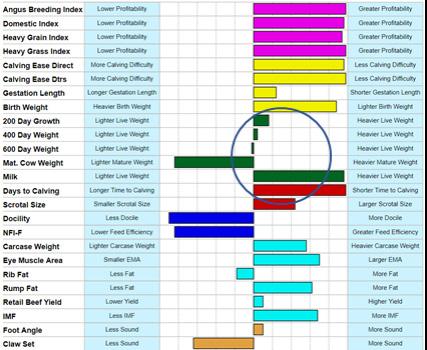
5 minute read
Using a selection Index in a breeding program A tool to genetic selection
Jake Phillips, Breed Development Officer
Across the world, animal breeding selection indexes have been a crucial tool utilised to make genetic gains in multiple traits of importance at one time. Selection index usage has been well adopted in a multitude of plant and animal species across the world.
Examples of the successful implementation of using selection indexes include in plant breeding for broad acre crops where multiple factors impact the economic benefit such as yield, flowering time and disease resistance. In other animal industries such as the sheep industry, has used selection indexes for selecting on wool quality and a clear breach to prevent fly strike and in the pork industry for the number of piglets successfully farrowed and the days it will then take them to reach the market specification. It should come as no surprise that the tools available to Angus Australia members to make genetic selection and breeding decisions also include selection indexes for consideration. The availability of these industry and market relevant selection indexes for use by Angus cattle breeders is part of Angus Australia’s continual quest to provide the very best and latest tools to utilise when making breeding decisions. A step-by-step guide to using a selection index when making breeding decisions
1. Define your breeding objective.
Before considering decisions regarding bull selection, it is important to develop a clearly defined plan of what you are attempting to achieve from your breeding program. This may be described as setting a breeding objective or breeding goals, and should consider aspects such as the relative economic importance of different traits, future customer requirements, future herd production targets, current herd performance, and the environment in which your breeding enterprise is run.
3. Identify the selection index which is most aligned with your breeding objective.
Background information regarding all the selection indexes published in the TransTasman Angus Cattle
Evaluation can be found on the Angus Australia website under the TACE menu and then Understanding Angus
Selection Indexes.
4.Rank animals on the selection index of relevance
Use the ‘Database Search’ function of the Angus
Australia website to rank the animals available for selection on the selection index of most relevance to your breeding objective. For example, animals available in a sale or semen catalogue.
5. Consider individual EBVs
Modify your search by adding minimum or maximum acceptable EBV values for your four or five key traits of importance in the additional criteria EBV Tab. A suggestion could be placing these limits to avoid the extremes by using breed average to ensure you then only search animals with breed average or more desirable in those traits important to you. The revised list will now show animals that meet your minimum criteria and show them in ranking order to the economic index you have decided to use.
6.Consider additional selection criteria
Modify your search to include any additional selection criteria or other information not captured in the selection index such as unique property management differences, pedigree, docility, research EBVs and importantly a robust structural and physical examination which may include fertility checks in crush side semen testing as well as morphology . Why is it important to follow a step by step approach to genetic selection? The nature of how a selection index works means that it is possible that the combination of traits can lead to animals having the same selection index value (Fig3). This means that without adding additional criteria to your selection such as nominating an acceptable range for some traits you could consequentially be considering using genetics that will not be best placed to give you genetic gains in the traits important to your operation. Consequentially, there could be other options that suit your breeding objective better (Fig 4.). This is because traits have a variation of heritabilities and correlations including some which mean if you select on individual traits you may in fact be causing unintended negative responses in traits which lead to an undesirable response, hence why the utilisation of a selection index helps to reduce the risk this complex conundrum poses for cattle breeders.



Figure 4. An example of two sires with the same selection index value but significantly different growth and mature cow weight EBV values

Figure 3. Two different animals with the same Economic Index value and different individual EBV values
Essentially selection Indexes allow genetic gains to be made across multiple traits at once, however it is important to ensure the animal you are considering using has individual EBVs that suit your requirements and meet your breeding objective. Getting help
Assistance in the use of selection indexes is available from Angus Australia’s nationwide team of Breed Development Officers. Contact details are available from the Angus Australia website.
Key points:
· Selection indexes have been used across animal and plant breeding for decades · Define a breeding objective and identify a selection index that best suits your situation. · Use the selection index to rank the potential sires or sale animals you are looking at · Consider EBVs for key traits, along with other information important to you to filter potential options being looked at. · Always incorporate a robust physical examination and consider measurements and traits not included in the calculation of the selection index such as structural soundness, fertility (bull semen testing), docility (both of the individual itself and his EBV), and any other items important to your operation. · Review the decisions you have made on genetic improvement of your herd to ensure you are proactive in planning your next breeding season.












